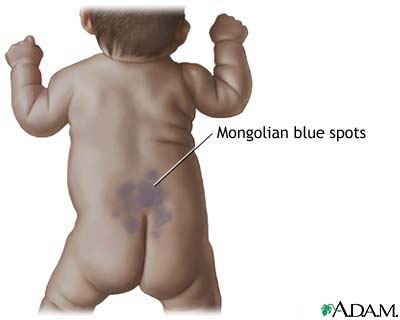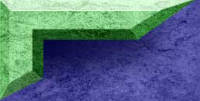|
Mongolian blue spots

 |
- A blue-black area or areas of skin, mostly on the lower back and/or buttocks, first seen in the neonatal period.
Sometimes it is widespread on the back, or might be on the shoulders. It is due to melanin pigment in the dermis.
- The blue-black area is flat in the skin (not raised) and is often 1 to 2 inches in diameter, and does not have a distinct
border. It is non-tender, and is generally seen in black, Asian, or Latin babies. Caucasian babies occasionally
have this condition.
|
 |
- By the pale blue-green or pale blue-black color and the location
|
 |
- None -- the spots usually disappear after a number of years, typically after 4 or 5 years. Sometimes they persist
into adulthood.
|
 |
- This is a harmless condition, which can be confirmed by showing the spots to your physician. When looking at the
Mongolian spot, it appears to be deep in the skin layers and is usually a pale blue-gray or pale blue-black, without intense
color.
|
 |
- Other birthmarks usually have a blatant color (such as a hemangioma which is a birthmark containing blood vessels giving
it various characteristic colors), and are not pale. A Mongolian spot, however, derives its color from melanin pigment
in the dermis and is pale because it lies deep in the skin layers.
- Other birthmarks often contain the color red or brown or are deeply blue (not pale blue).
- A bruise from injury would change rapidly over a period of days, and would usually have a very sharp border and extend
into the most superficial layer of the skin, distinguishing it from a Mongolian spot. The Mongolian spot is in a deep
layer of the skin (the dermis) and always has an indistinct border.
| |
|
|
|
|

